Key takeaways:
- Creativity in education fosters critical thinking, problem-solving, and collaboration among students, transforming setbacks into opportunities for innovation.
- Encouraging student-led projects and providing autonomy enhances engagement and ownership, allowing students to connect their interests with their learning.
- Integrating creativity through open-ended projects and interdisciplinary lessons allows students to explore topics deeply and express themselves effectively.
- Reflecting on the creative process supports students’ growth and encourages a culture of continuous improvement and self-exploration.
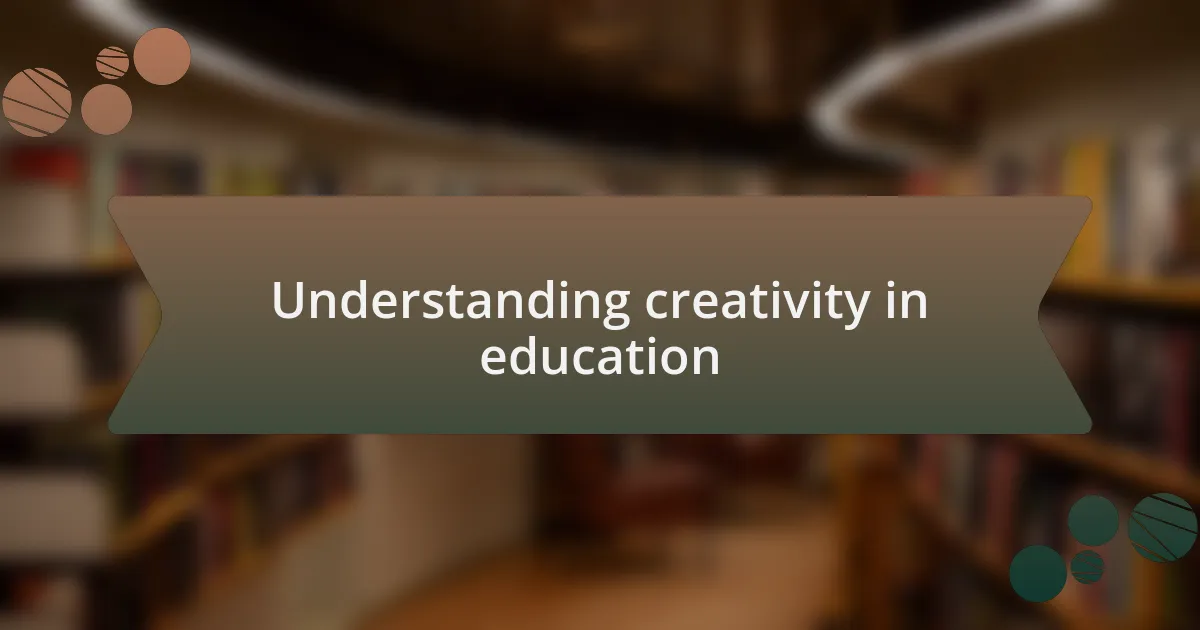
Understanding creativity in education
Creativity in education goes beyond mere artistic expression; it is about fostering an environment where students feel safe to explore their ideas. I recall a day in my classroom when I asked students to express their thoughts on a challenging subject through visual art. The creativity that emerged was not just in the artwork but in the conversations and connections they formed while sharing their pieces.
Understanding the different dimensions of creativity in education is crucial. Have you ever observed how a simple prompt can lead to diverse interpretations and innovations? It’s fascinating to witness students take the same concept and run in completely different directions. I remember a project on renewable energy where one student created a model using recycled materials while another wrote a poetic reflection on its importance. This variety not only showcases individual strengths but also encourages collaboration and mutual respect among peers.
Moreover, creativity is not just a luxury; it is essential for developing critical thinking and problem-solving skills. I often find myself pondering how we can create more opportunities for students to experiment and think outside the box. For instance, when I introduced a “failure wall” where students could share failed attempts at projects, the atmosphere shifted dramatically. Students began to view setbacks not as disasters but as stepping stones towards innovation. This shift in perspective is at the heart of understanding creativity in education.
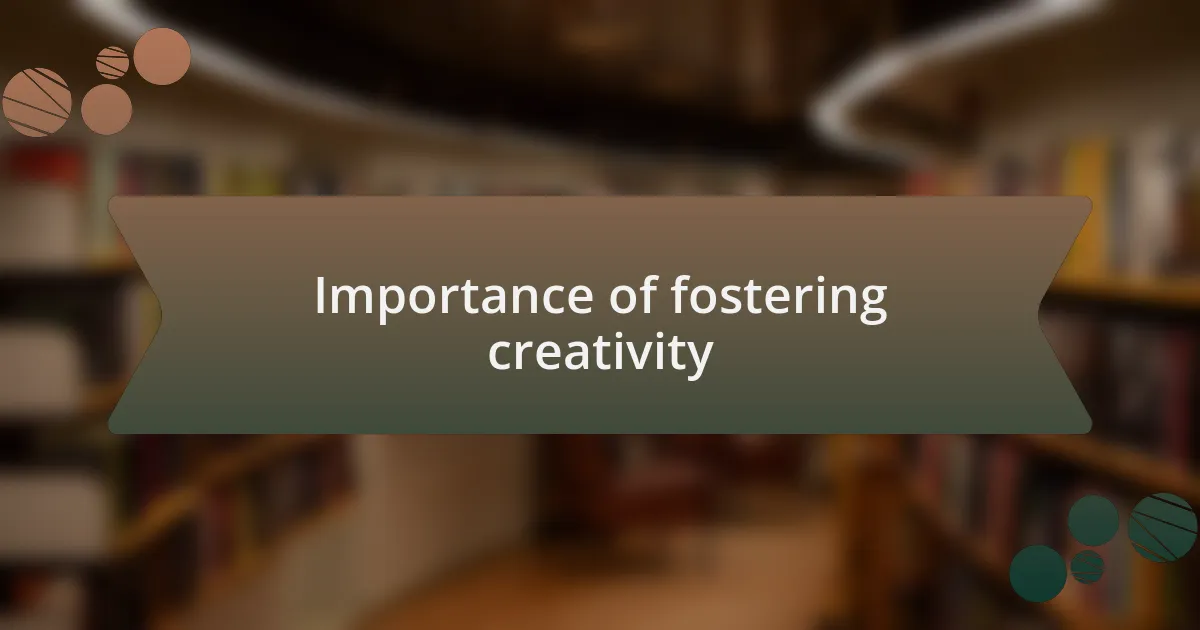
Importance of fostering creativity
Fostering creativity is crucial in education because it equips students with the tools to navigate an ever-changing world. I recall a moment in my classroom when a student faced a complex math problem. Instead of opting for the standard methods, she created an innovative game that simplified the concepts. Watching her approach highlighted how creativity can transform challenges into engaging learning experiences.
Creativity also cultivates resilience, allowing students to embrace uncertainty and take risks. During a group project on climate change, one student struggled to convey his idea. Instead of giving up, he enlisted the help of his peers, leading to a brainstorming session that sparked new insights. Witnessing this collaboration reinforced the idea that creative spaces can nurture confidence and foster community among students.
Ultimately, creativity prepares students for a future where adaptability is key. Have you ever seen students light up when they realize their ideas can have real-world applications? I certainly have, and it emphasizes that creativity is not just about art; it’s about empowering learners to express themselves, think critically, and innovate. Engaging students in creative thinking today is essential for their success tomorrow.
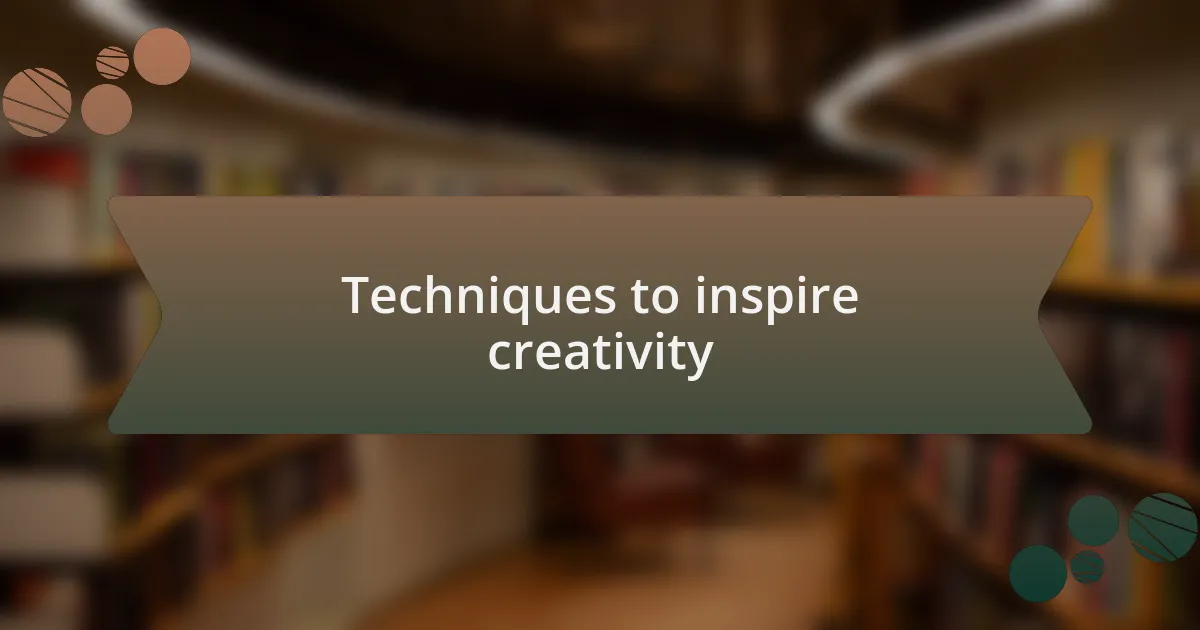
Techniques to inspire creativity
One effective technique to inspire creativity is to provide students with open-ended projects. When I gave my students the freedom to design their own science experiments, I was amazed by their enthusiasm. One student crafted a model to demonstrate renewable energy, incorporating everyday materials. The excitement in his eyes as he presented his project reminded me that creativity flourishes when students feel ownership over their learning.
Incorporating collaborative brainstorming sessions can also ignite creativity. I remember hosting a session where students shared their wildest ideas on enhancing local wildlife habitats. The energy in the room was infectious, as students bounced ideas off each other. Can you imagine how powerful it feels to witness students build on one another’s thoughts? This kind of collaboration often leads to unexpected and innovative solutions.
Another technique I’ve found effective is integrating arts into various subjects. One time, we approached a history lesson through storytelling, where students created skits about historical figures. I could see their passion emerge as they explored and interpreted different perspectives. When students engage with content creatively, they don’t just memorize facts; they connect emotionally and personally, which deepens their understanding and retention of the material.
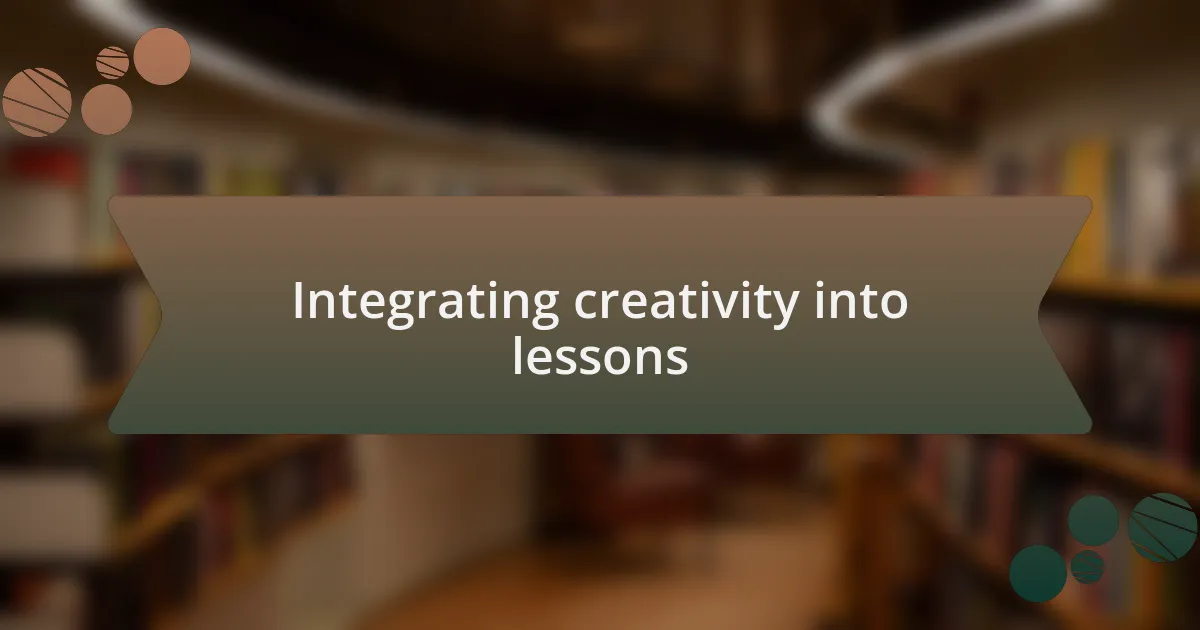
Integrating creativity into lessons
One way I integrate creativity into lessons is through themed project-based learning. For instance, during a unit on ecosystems, I had my students create a “living museum” where each group showcased a different biome. The excitement was palpable as they crafted displays using recycled materials and even performed short presentations. I will never forget the pride on their faces when their peers applauded their hard work. It really brought to life the idea that learning can be an artistic expression.
I also find that incorporating technology allows students to explore their creativity uniquely. Last semester, I guided my students in creating digital storytelling projects where they combined narratives with visuals and sound. Watching them experiment with different formats was enlightening; it was a reminder that technology can be a powerful medium for self-expression. Have you ever seen students discover their voice through technology? It’s truly inspiring to see them embracing the platform to share their ideas.
Additionally, I love to intertwine various disciplines within my lessons to foster creativity. For example, in a recent math class, I had students design their own board games that incorporated mathematical concepts. The room was filled with laughter and collaboration as they worked together to develop rules and gameplay mechanics. I could see how the blending of math with creativity transformed their understanding into something tangible. Isn’t it fascinating how creativity can make even the most abstract concepts come alive?
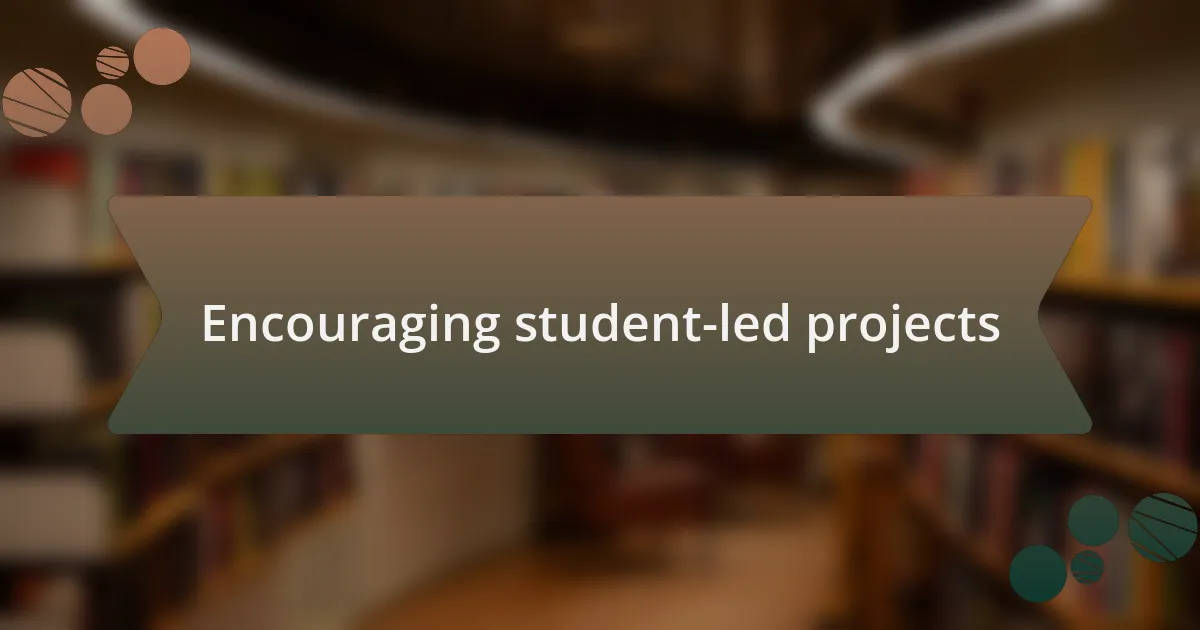
Encouraging student-led projects
One effective approach to encouraging student-led projects is giving them the autonomy to choose their topics. I often find that when students select what they are passionate about, their engagement skyrockets. For example, a student once chose to investigate renewable energy sources for a project. The enthusiasm he exhibited while conducting interviews with local experts and creating a presentation was infectious. Have you ever watched a student light up when they connect their interests with their learning? It’s a powerful reminder that ownership fosters creativity.
Equipping students with the necessary tools and guidance also plays a crucial role in their project success. I remember a time when I organized a “Project Pitch Day,” where students presented their ideas to peers and received constructive feedback. It was rewarding to see them refine their concepts based on the input received, enhancing their critical thinking skills in the process. It made me wonder: how often do we miss opportunities by not allowing students to collaborate and iterate on their ideas?
Moreover, celebrating the outcomes of these projects can further amplify their motivation. I like to host showcases where students present their work to parents, school staff, and the community. I vividly recall a showcase centered around a social issues campaign created by a group of students. The passion they demonstrated while explaining their projects was heartwarming. When students see the tangible impact of their efforts on others, it’s a profound experience that reinforces their sense of purpose and creativity. Isn’t it fascinating how recognition can elevate their work to a new level?

Reflecting on student creativity
Reflecting on student creativity often opens up a treasure trove of insights into their unique abilities. I once had a student who struggled with traditional assessments but found a voice through poetry. Watching her transform her emotions into heartfelt verses was a revelation. How often do we underestimate the power of expression in showcasing a student’s creativity?
In another instance, I introduced a reflection journal exercise where students documented their creative process throughout a project. One student articulated how moments of frustration often led to unexpected breakthroughs, reminding me of the importance of embracing challenges as part of the creative journey. Have you noticed how reflection can sometimes lead to a deeper understanding of one’s creative capabilities?
Through these experiences, I’ve learned that encouraging students to reflect on their creative endeavors not only helps them recognize their growth but also fosters a culture of continuous improvement. Recently, during a class discussion, students shared their reflections on what inspired their innovative ideas. Hearing them articulate their thought processes made me realize how vital it is to create spaces for self-exploration. Doesn’t it just thrill you to see students connect the dots between their insights and their creative expressions?
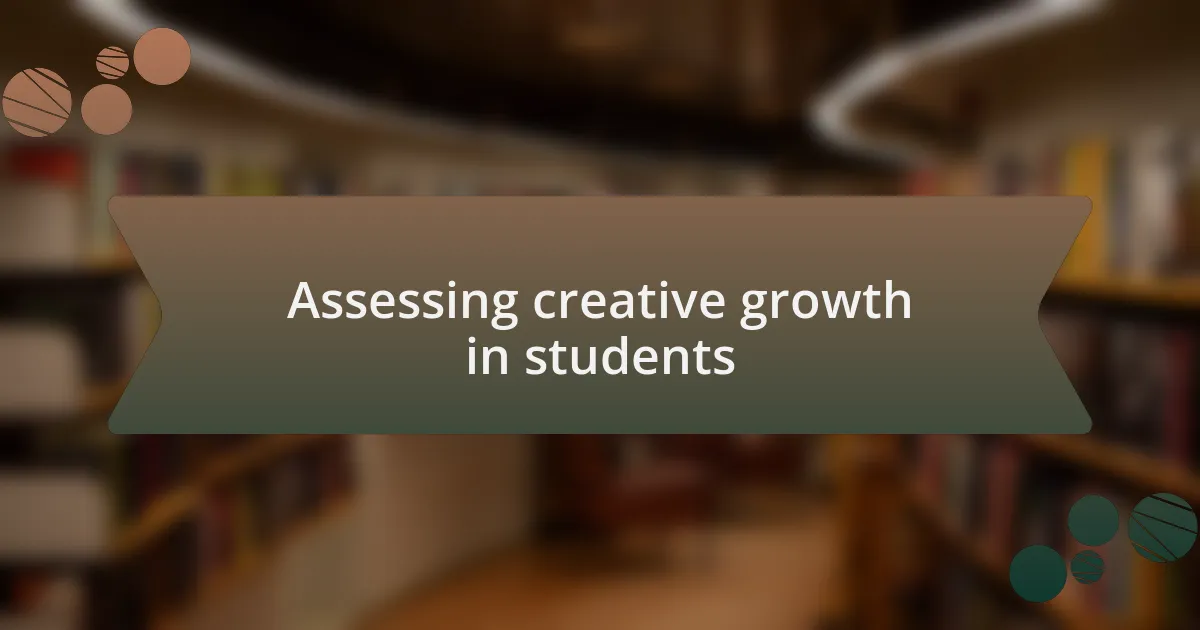
Assessing creative growth in students
When assessing creative growth, I often look beyond the final product. For instance, I once had a student who brought in a disorganized art project that initially seemed chaotic. Yet, through a conversation about her ideas and the decisions she made during the process, I discovered a rich narrative behind her creative choices. How often do we dive deep enough to find the meaning in what appears to be a mess?
I also find that self-assessment can be incredibly enlightening. I had a group project where students created a mini-documentary. At the end, I asked them to evaluate not only the final video but also their individual contributions and feelings throughout the project. Some students expressed surprise at how much they had developed their ideas collaboratively. Isn’t it fascinating how creativity can flourish in a supportive environment where students feel safe to share their thoughts?
Observation plays a crucial role in this process. While working with a particularly vibrant class of young artists, I noticed that some students thrived on collaboration, while others preferred solitary exploration. This taught me the importance of tailored feedback. By acknowledging each student’s unique path, I can effectively nurture their creative journeys. How rewarding it is to witness their growth when we adapt our approaches to meet their needs!